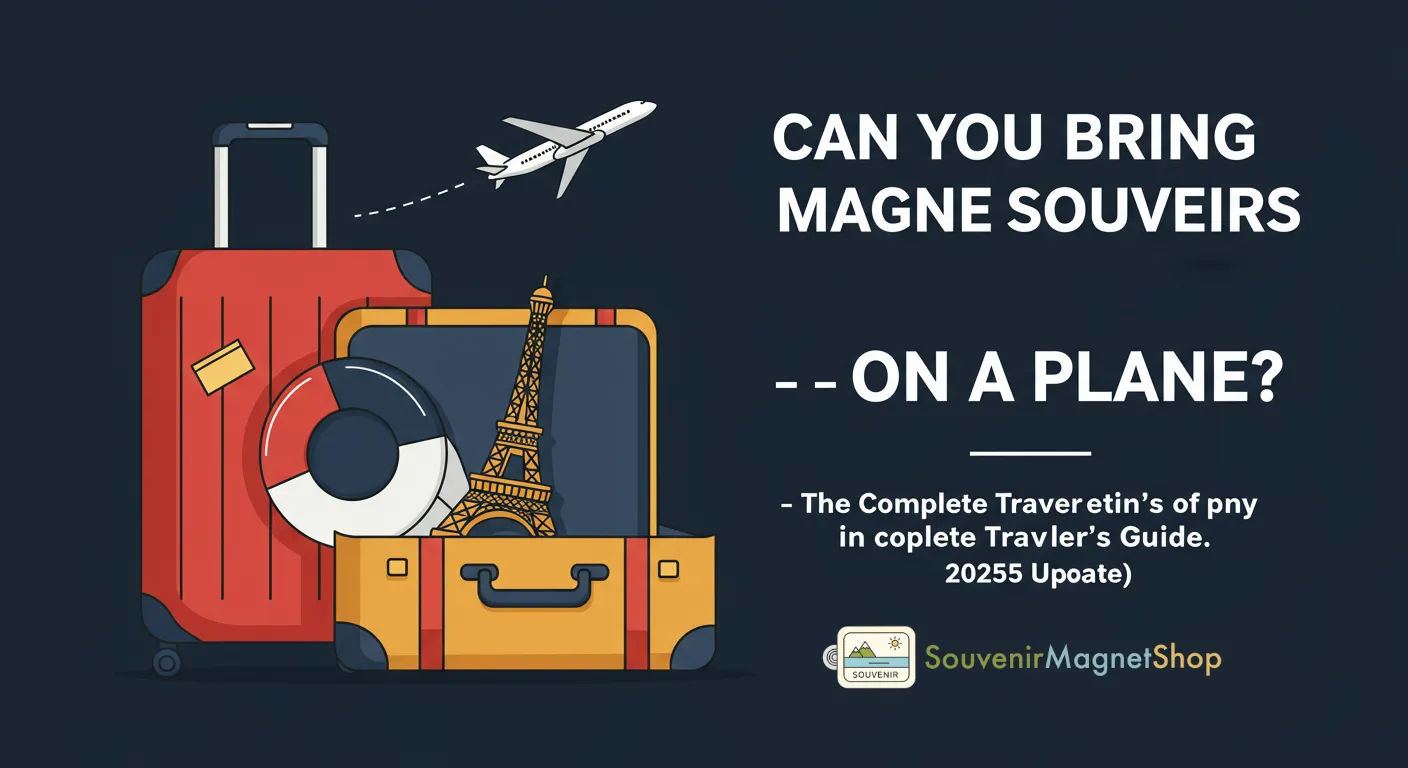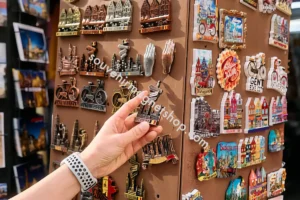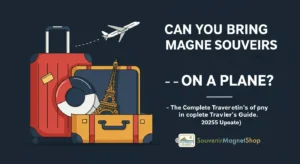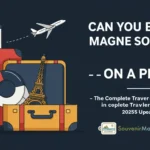Can You Bring Magnet Souvenirs on a Plane? — The Complete Traveler’s Guide (2025 Update)

1. The Short Answer: Yes, You Can!
If you love collecting souvenir fridge magnets, good news — you can safely bring them on a plane, both in your carry-on and checked luggage.
Most souvenir magnets are too weak to interfere with aircraft navigation systems and are fully approved for air travel under FAA and IATA guidelines.
Still, understanding a few simple rules and smart packing tips will help you avoid delays and keep your magnets safe from damage.
2. Airline Regulations: What the FAA & IATA Say
Airlines regulate magnetic field strength, not magnet type or purpose.
According to the FAA (Federal Aviation Administration), any magnetic item is safe for air transport if the magnetic field measured 4.5 meters (15 feet) away is less than 0.00525 gauss (5.25 milligauss).
The IATA (International Air Transport Association) classifies magnets as:
| Category | Description | Allowed on Flights |
|---|---|---|
| A – Non-magnetic items | Field < 0.002 gauss at 2.1m | ✅ Yes |
| B – Magnetic materials | Field < 0.00525 gauss at 4.6m (UN2807 label required) | ⚠️ Conditional |
| C – Strong magnets | Above 0.00525 gauss | ❌ Not allowed |
These standards exist to protect aircraft navigation systems — though modern planes use GPS, the magnetic compass remains a crucial backup.
3. Souvenir Magnets Are Safe
For travelers, the key takeaway is simple:
Regular souvenir fridge magnets are completely safe
The TSA (Transportation Security Administration) explicitly lists small decorative magnets and souvenir fridge magnets as permitted items in both checked and carry-on bags.
Most travel magnets — whether resin, metal, or ceramic — generate extremely weak fields, far below the allowed threshold.
They’re also one of the most popular souvenirs worldwide: according to Statista, 43% of travelers buy fridge magnets as their primary keepsake. They’re small, inexpensive, and carry emotional value without taking up luggage space.
4. Types of Magnets and What’s Allowed
| Type | Example | Allowed on Planes |
|---|---|---|
| Souvenir fridge magnets | 3D resin, printed, hand-painted | ✅ Yes |
| Magnetic toys | SmartMax, building blocks | ✅ Yes |
| Phone magnetic accessories | MagSafe chargers, cases | ✅ Yes |
| Industrial neodymium magnets | Large NdFeB or SmCo blocks | ⚠️ / ❌ Restricted |
| Magnet fishing or industrial magnets | Over 150 lbs pull force | ❌ No |
Quick test: If a paper clip does not stick through the packaging, the magnet is safe to fly with.
5. Real Traveler Experiences
Travel forums and Reddit users consistently confirm that souvenir magnets pass security without issue.
Some travelers even bring hundreds of magnets from different countries — the key is proper packaging:
“I carried 200 souvenir magnets home from Italy in my checked luggage. Wrapped them in bubble wrap and clothes — no problem at all.”
However, industrial-strength magnets can trigger extra inspection, so those should be declared or shipped separately.
6. Packing Tips
Even if allowed, smart packing ensures your magnets arrive undamaged and pass security smoothly:
- Wrap each magnet in bubble wrap or soft cloth
- Separate layers with cardboard or plastic sheets
- Pack them in the middle of your suitcase, surrounded by clothes
- Alternate magnetic poles (north-south) to cancel out magnetic fields
- Avoid putting too many in one box
Bonus Tip: Ceramic or resin magnets are fragile — small gift boxes provide extra protection.
7. Airline & Regional Differences
- U.S. Airlines (Delta, United, American) – Follow TSA/FAA rules, allowing all weak magnets in both carry-on and checked baggage.
- European & Asian airlines – Generally follow IATA rules; industrial magnets may require declaration.
- UPS / DHL / FedEx – Reject strong magnets exceeding 0.00525 gauss at 4.6m (UN2807 class).
In short, if your magnets are for decoration or souvenirs, you’re completely safe.
8. Special Items: Magnetic Therapy or Medical Devices
Magnets used in medical supports or therapeutic gear (like magnetic knee braces) are also allowed, but it’s a good idea to carry documentation if requested by security officers.
9. Eco Trends: Souvenir Magnets Go Sustainable
In 2025, the souvenir market is shifting toward eco-friendly, hand-painted designs and locally inspired themes.
Travelers increasingly prefer:
- Wooden or ceramic handmade magnets
- Cultural or minimalist landmark designs
- Personalized magnets with names or travel dates
- Limited-edition collectible series
At SouvenirMagnetShop, we focus on offering these artistic, durable, and meaningful designs — all at just $4.99 each with worldwide delivery.
10. Final Takeaway
Can you bring souvenir magnets on a plane?
Absolutely yes — as long as they’re regular decorative magnets.
Key points to remember:
- Souvenir magnets are well below the magnetic field limit (0.00525 gauss).
- TSA and global authorities explicitly allow weak magnets in both luggage types.
- Wrap carefully to prevent damage.
- Avoid packing industrial or high-strength magnets.
- Perfectly safe for travelers and collectors alike.
So next time you’re exploring Rome’s Colosseum, Paris’s Eiffel Tower, or Tokyo’s temples, don’t hesitate to pick up that souvenir magnet — it’s safe to fly home with you and hold your travel memories forever.
11. List of Official/Authoritative Sources
Regulatory Bodies and Industry Standards
1. Federal Aviation Administration (FAA)
- Link: https://www.faa.gov/hazmat/packsafe/magnets
- Description: The official FAA guide on safe packaging for hazardous materials, specifying air transport requirements for magnets to prevent interference with navigation systems.
2. International Air Transport Association (IATA)
- Link: https://www.iata.org/en/publications/dgr/
- Description: The homepage for IATA’s Dangerous Goods Regulations (DGR), the global industry standard for the commercial air transport of magnetic substances.
- Link: https://www.iata.org/contentassets/b08040a138dc4442a4f066e6fb99fe2a/dgr-66-addendum-1—en.pdf
- Description: Direct reference document for IATA DGR Addendum 1 to the 66th edition, containing classification and detailed requirements for magnetic materials.
- Link: https://www.iata.org/contentassets/90f8038b0eea42069554b2f4530f49ea/dgr_65_addendum_en.pdf
- Description: Direct reference document for IATA DGR Addendum to the 65th edition, providing context for historical and current standards.
Official Airline Regulations (Following FAA/IATA Standards)
1. Delta Air Lines
- Link: https://www.delta.com/us/en/baggage/prohibited-or-restricted-items/overview
- Description: Delta Air Lines’ official overview of prohibited or restricted items in baggage.
2. United Airlines
- Link: https://www.united.com/en/us/fly/baggage/dangerous-items.html
- Description: United Airlines’ official regulations regarding dangerous goods in baggage.
These are our source materials. The article content is primarily based on officially published information from these authoritative organizations and bodies, combined with reliable commercial guides and real traveler experiences to ensure accuracy and practicality.






